Vimar 03826 Handleiding
Vimar
Alarmsysteem
03826
Bekijk gratis de handleiding van Vimar 03826 (4 pagina’s), behorend tot de categorie Alarmsysteem. Deze gids werd als nuttig beoordeeld door 17 mensen en kreeg gemiddeld 4.5 sterren uit 9 reviews. Heb je een vraag over Vimar 03826 of wil je andere gebruikers van dit product iets vragen? Stel een vraag
Pagina 1/4

Viale Vicenza, 14
36063 Marostica VI - Italy
www.vimar.com
49401904A0 03 2402
03826
BY-ALARM PLUS
Sirena By-alarm Plus da esterno autoalimentata, collegamento alla centrale
via BUS, 2 speakers piezoelettrici, segnalazione allarme a LED, alimentazione
13,8 Vdc, installazione a parete. Batteria tampone esclusa. Bolla montaggio
facile, led stato impianto, protezione anti-apertura, anti-strappo e antischiuma.
La sirena, collegata al BUS p1-ma autoalimentata internamente, è gestita attraverso un microproces-
sore che permette di monitorare costantemente tutti i parametri del dispositivo. La sirena riceve
l'alimentazione ed i comandi direttamente dal bus BUS.
COLLEGAMENTI
Il collegamento con la centrale va effettuato con un cavo schermato a 4 (o più) fili.
Attenzione: La calza va collegata ad uno dei morsetti di massa (o GND) solo dal lato della
centrale e deve seguire tutto il BUS senza essere collegata a massa in altri punti.
Il collegamento della sirena va effettuato sui morsetti “+ D S -”.
BATTERIA DELLA SIRENA (NON FORNITA)
Alimenta la sirena in caso di manomissione e/o assenza di alimentazione di rete della linea di
collegamento con il resto dell’impianto. Deve essere sempre presente, poichè, in caso di allarme,
fornisce energia necessaria per sviluppare la potenza sonora prevista e per l’alimentazione del
lampeggiatore. Viene mantenuta in carica tramite l’alimentazione a 12 V.
178
0,5
35
0,5
60
0,5
N.B. Si raccomanda di rispettare le polarità in fase di installazione (rosso=positivo, nero=negativo).
In caso di batteria scarica e con tensione inferiore ai 10.5 V la sirena interrompe la riproduzione
delle segnalazioni sonore mantenendo però quelle luminose.
INSTALLAZIONE
1. Scegliere la posizione idonea all’installazione del dispositivo. La sirena va posizionata su una
superficie piana ed in una posizione difficilmente accessibile p1-ma ben visibile in modo che svolga
un ruolo da deterrente contro eventuali tentativi di effrazione.
2. Togliere l’alimentazione all'impianto elettrico.
3. Rimuovere il coperchio.
4. Far passare i cavi attraverso il foro passacavi
5. Se si desidera attivare l’antistrappo inserire la vite nell’apposito foro; prestare attenzione che il
microswitch sia posizionato più in basso rispetto la vite.
6. Inserire la batteria tampone nell’apposito alloggio e cablarla rispettando le polarità.
7. Cablare la sirena.
8. Effettuare la procedura di arruolamento.
9. Chiudere il coperchio centrando i fori ed avvitare con le viti fornite. Il microswitch di sabotaggio
si chiude e il LED DL7 (rosso) lampeggia con un periodo di 2 s per un totale di 20 s; al termine
del lampeggio la sirena è operativa e funzionante.
CONFIGURAZIONE
Una volta che la sirena è arruolata (mediante il pulsante P1 e i LED 1 e 2) può essere configurata
attraverso la programmazione della centrale.
ES01 ES02
R4
E
CPH1
1
P1 2
R5
D1
D2
Per tutti i dettagli si vedano i manuali di installazione del sistema By-Alarm Plus e del software
By-alarm Manager Plus.
FUNZIONAMENTO
La sirena effettua diversi tipi di segnalazioni luminose e acustiche; tali segnalazioni si attivano o
meno a seconda della categoria dell’evento scatenante e della programmazione della centrale.
Per alcune di queste categorie è possibile programmare la durata della segnalazione e la pre-
senza/velocità del lampeggiatore.
TIPI DI SEGNALAZIONE
Lampeggiatore
Il segnale luminoso ad alta intensità è generato mediante un flash stroboscopico. Il lampeggiatore
si attiva con una frequenza di 36 o 108 flash al minuto in caso di mancanza di alimentazione o
sabotaggio, se così programmato.
LED di stato
Ai lati del lampeggiatore sono presenti due LED ausiliari utilizzabili sia per le segnalazioni di allar-
me che di supporto alla programmazione.
Il LED DL7 (rosso), durante la fase di installazione, si comporta come segue:
• Acceso fisso = Installazione in corso a coperchio aperto. In questo stato la sirena non emette
segnalazioni acustiche o luminose.
• Lampeggiante = Alla chiusura del coperchio il led lampeggia per 20 s a indicare che la sirena
sta per passare in stato di normale funzionamento. Al termine del lampeggio la sirena è ope-
rativa e funzionante.
Nel normale funzionamento il LED di stato viene attivato su segnalazione se così programmato.
Il LED DL8 (verde) durante il normale funzionamento si accende su segnalazione se così pro-
grammato.
LED di programmazione
I LED 1 e 2 in fase di arruolamento indicano l'indirizzo assegnato al dispositivo.
Segnalazione acustica
La categoria dell'evento programmato per l'attivazione della sirena determina il tipo di suono fra
quelli disponibili.
ATTIVAZIONI DELLA SIRENA
Le sirene possono essere attivate sia dalla centrale che da eventi generati dalla sirena stessa in
caso di assenza della comunicazione su BUS. Le attivazioni terminano quando si verifica una
delle seguenti condizioni:
- il ripristino della condizione di riposo;
- lo scadere del tempo massimo di allarme.
Eventi della sirena
La sirena 03826 genera degli eventi a cui possono essere associate una o più segnalazioni.
Evento sirena Azione/segnalazione
Mancanza di alimentazione Programmabile da software By-alarm Plus
Manager (si veda il rispettivo manuale)
Problemi batteria Evento di guasto in centrale
Antischiuma sporco Evento di guasto in centrale
Manomissioni sirena:
- apertura coperchio/strappo dal muro
- antischiuma
- attacco termico (aumento/diminuzione
rapida della temperatura; lancia termica o
congelamento forzato)
Evento di sabotaggio in centrale
REGOLE DI INSTALLAZIONE
L’installazione deve essere effettuata da personale qualificato con l’osservanza delle disposizioni
regolanti l’installazione del materiale elettrico in vigore nel paese dove i prodotti sono installati.
CARATTERISTICHE
• Tensione di alimentazione:
- nominale: 13,8 V
- range: da 9 a 16 V
• Assorbimento:
- 220 mA in funzionamento
- 140 mA in stand-by
• Livello di pressione sonora: 108 dB
• Livelli minimi di pressione sonora a 1 m:
- tono 1: 99,0 db(A)
- tono 2: 98,6 db(A)
- tono 3: 98,4 db(A)
- tono 4: 97,4 db(A)
• Frequenza di suono: 2000 Hz/3000 Hz
• Lampeggi al minuto: 36, 108
• Batteria alloggiabile: 12 Vdc 2,1 Ah classe di infiammabilità UL94-HB
• Tensione di segnalazione "batteria bassa": 11,5 Vdc
• 2 altoparlanti piezoelettrici
• Segnalatore luminoso flash stroboscopico
• Dispositivo antiapertura
• Dispositivo antistrappo
• Contenitore plastico
• Controllo e carica della batteria in funzione della temperatura ambientale
• Temperatura di funzionamento: -25..+55 °C
• Grado di protezione IP34
• Grado di sicurezza: 3
• Classe ambientale: IV
• Dimensioni (L x A x P): 218 x 237 x 54.7 mm
CONFORMITA' NORMATIVA.
Direttiva EMC. Direttiva RoHS
Norme EN 62368-1, EN 50130-4, EN 50130-5, EN 55032, EN 50131-4, EN IEC 63000.
Regolamento REACh (UE) n. 1907/2006 – art.33. Il prodotto potrebbe contenere tracce di
piombo.

Viale Vicenza, 14
36063 Marostica VI - Italy
www.vimar.com
49401904A0 03 2402
03826
BY-ALARM PLUS
By-alarm Plus self-powered outdoor siren, connection to the control unit via
BUS, 2 piezoelectric speakers, LED alarm signalling, 13.8 VDC power supply,
surface mounting. Buffer battery not included. Spirit level for easy installation,
system status LED, anti-tamper protection, anti-removal and anti-foam.
The siren, which is connected to the BUS but self-powered internally, is managed by a
microprocessor that can continuously monitor all device parameters. The siren receives both its
power supply and controls directly from the BUS.
CONNECTIONS
Connect it to the control unit with a 4-wire (or more) shielded cable.
Caution: Connect the shield to one of the earth (or GND) terminals at the control unit end only,
and ensure that it follows the entire BUS without being connected to earth at any other point.
Connect the siren to the “+ D S -” terminals.
SIREN BATTERY (NOT INCLUDED)
This powers the siren in the event of tampering and/or no mains voltage on the line connecting
to the rest of the system. It must always be present since, in the event of an alarm, it supplies
the energy necessary to develop the required sound power and to supply the flashing light. The
12 V power supply keeps it charged.
178
0,5
35
0,5
60
0,5
N.B. Always observe the polarity during installation (red = positive, black = negative).
If the battery is flat and its voltage is lower than 10.5 V, the siren stops sounding, while the light
indicators remains on.
INSTALLATION
1. Choose a suitable location to install the device. Position the siren on a flat surface, in a place
that is hard to access but clearly visible so that it acts as a deterrent against attempted break-
ins.
2. Cut off the power supply to the electrical system.
3. Remove the cover.
4. Route the cables through the cable outlet holes.
5. If you want to activate the anti-removal protection, insert the screw into the corresponding
hole; take care to position the microswitch lower than the screw.
6. Insert the buffer battery into its housing and wire it with the correct polarity.
7. Wire the siren.
8. Perform the enrolment procedure.
9. Close the cover, taking care to centre the holes, and tighten the screws provided. The anti-
tamper microswitch will close and LED DL7 (red) will flash every 2 s for 20 s; when the flashing
stops, the siren is ready and operational.
CONFIGURATION
Once the siren has been enrolled (using push button P1 and LEDs 1 and 2) it can be configured
by programming the control unit.
ES01 ES02
R4
E
CPH1
1
P1 2
R5
D1
D2
Refer to the By-Alarm Plus system installation manual and the By-Alarm Plus Manager software
manual for all the details.
OPERATION
The siren performs different kinds of optical and acoustic signalling; these signalling modes are
activated or not according to how the control unit is programmed and on the category of the
triggering event. For some of these categories, the duration of the signalling and the presence/
speed of the flashing light can be programmed.
SIGNALLING TYPES
Flashing light
The high-intensity light signal is generated by a stroboscopic flash. The flashing light is activated
with a frequency of 36 or 108 flashes per minute when there is no power supply or in the event
of tampering, if programmed to do so.
Status LED
There are two auxiliary LEDs at the sides of the flashing light, which serve to indicate alarms and
to support programming.
LED DL7 (red) behaves as follows during installation:
• On continuously = Installation in progress and cover open. In this state, the siren does not emit
acoustic or luminous signalling.
• Flashing = When the cover is closed, the LED flashes for 20 s to indicate that the siren is
about to go into normal operation state. When the flashing ceases, the siren is operational
and working.
During normal operation, the status LED is activated by a signal if programmed to do so.
LED DL8 (green) is switched on by a signal if programmed to do so during normal operation.
Programming LEDs
LEDs 1 and 2 indicate the address assigned to the device during the enrolment phase.
Acoustic signalling
The category of the event programmed to activate the siren defines the type of sound among
those available.
SIREN ACTIVATION
The sirens can be activated from either the control unit or events generated by the siren itself in
the absence of communication on the BUS. Activation ends when one of
the following conditions applies:
- the rest condition is restored;
- the maximum alarm time lapses.
Siren events
Siren 03826 generates events that can be associated with one or more signalling modes.
Siren event Action/signalling
No power Programmable via the By-alarm Plus
Manager software (please refer to the
relevant manual)
Battery problems Fault in the control unit
Anti-foam device dirty Fault in the control unit
Siren tampering:
- cover opening/ripping from the wall
- anti-foam
- thermal attack (rapid temperature increase/
decrease; oxygen lance or forced freezing)
Sabotage in the control unit
INSTALLATION RULES
Installation must be carried out by qualified persons in compliance with the current regulations
regarding the installation of electrical equipment in the country where the products are installed.
CHARACTERISTICS
• Power supply voltage:
- rated: 13.8 V
- range: 9 to 16 V
• Absorption:
- 220 mA during operation
- 140 mA on stand-by
• Sound pressure level: 108 dB
• Minimum sound pressure levels at 1 m:
- tone 1: 99.0 db(A)
- tone 2: 98.6 db(A)
- tone 3: 98.4 db(A)
- tone 4: 97.4 db(A)
• Sound frequency: 2000 Hz/3000 Hz
• Flashes per minute: 36, 108
• Battery that can be accommodated: 12 VDC 2.1 Ah flammability class UL94-HB
• "Low battery” signal voltage: 11.5 Vdc
• 2 piezoelectric speakers
• Stroboscopic flashing light
• Anti-tamper device
• Anti-removal device
• Plastic enclosure
• Battery monitoring and charging based on the room temperature
• Operating temperature: -25..+55 °C
• IP34 protection degree
• Safety class: 3
• Environment class: IV
• Dimensions (W x H x D): 218 x 237 x 54.7 mm
REGULATORY COMPLIANCE.
EMC directive. RoHS Directive
Standards EN 62368-1, EN 50130-4, EN 50130-5, EN 55032, EN 50131-4, EN IEC 63000.
REACH (EU) Regulation no. 1907/2006 – Art.33. The product may contain traces of lead.

Viale Vicenza, 14
36063 Marostica VI - Italy
www.vimar.com
49401904A0 03 2402
VISTA FRONTALE (dopo apertura del coperchio)
FRONT VIEW (with the cover open)
A: Morsetti +, D, S, - per il collegamento del BUS
B: Cavi batteria
C: Dispositivo antischiuma
D: LED di stato DL8 - Verde
E: Dispositivo anti-tamper/antistrappo
F: LED di stato DL7 - Rosso
G: Pulsante P1 e led di arruolamento
A
B C
D
EF
G
START
D11
12
DL7
ES01 ES02
R4
E
CPH1
IR1 IR2
OP1
1
P1
LABEL (FW)
IN325-R1
LABEL (QC)
2
R5
D
BATTERY
S
STOP
D1
D2
COLLEGAMENTI
CONNECTIONS
D+ –S
D+ –S
D+ –S
S
–
D
+
Centrale
Control unit
03800
03801
03802
BUS
Calza Shield•
Altri dispositivi BUS
Other devices BUS
Sirena BUS
BUS Siren
03826
A: +, D, S, - terminals for connecting the BUS
B: Battery cables
C: Anti-foam device
D: Status LED DL8 - Green
E: Anti-tamper/anti-removal device
F: Status LED DL7 - Red
G: Push buttons P1 and enrolment LEDs
RAEE - Informazione agli utilizzatori
Il simbolo del cassonetto barrato riportato sull’apparecchiatura o sulla sua confezione indica che il prodotto alla fine della propria vita utile deve essere raccolto separatamente dagli altri rifiuti. L’utente dovrà, pertanto, conferire l’apparecchiatura
giunta a fine vita agli idonei centri comunali di raccolta differenziata dei rifiuti elettrotecnici ed elettronici. In alternativa alla gestione autonoma, è possibile consegnare gratuitamente l’apparecchiatura che si desidera smaltire al distributore, al momento
dell’acquisto di una nuova apparecchiatura di tipo equivalente. Presso i distributori di prodotti elettronici con superficie di vendita di almeno 400 m
2
è inoltre possibile consegnare gratuitamente, senza obbligo di acquisto, i prodotti elettronici da
smaltire con dimensioni inferiori a 25 cm. L’adeguata raccolta differenziata per l’avvio successivo dell’apparecchiatura dismessa al riciclaggio, al trattamento e allo smaltimento ambientalmente compatibile contribuisce ad evitare possibili effetti
negativi sull’ambiente e sulla salute e favorisce il reimpiego e/o riciclo dei materiali di cui è composta l’apparecchiatura.
WEEE - User information
The crossed bin symbol on the appliance or on its packaging indicates that the product at the end of its life must be collected separately from other waste. The user must therefore hand the equipment at the end of its life cycle over to the
appropriate municipal centres for the differentiated collection of electrical and electronic waste. As an alternative to independent management, you can deliver the equipment you want to dispose of free of charge to the distributor when
purchasing a new appliance of an equivalent type. You can also deliver electronic products to be disposed of that are smaller than 25 cm for free, with no obligation to purchase, to electronics distributors with a sales area of at least 400 m
2
.
Proper sorted waste collection for subsequent recycling, processing and environmentally conscious disposal of the old equipment helps to prevent any possible negative impact on the environment and human health while promoting the
practice of reusing and/or recycling materials used in manufacture.
Product specificaties
| Merk: | Vimar |
| Categorie: | Alarmsysteem |
| Model: | 03826 |
Heb je hulp nodig?
Als je hulp nodig hebt met Vimar 03826 stel dan hieronder een vraag en andere gebruikers zullen je antwoorden
Handleiding Alarmsysteem Vimar
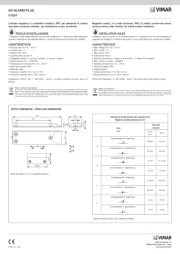
2 Juli 2025
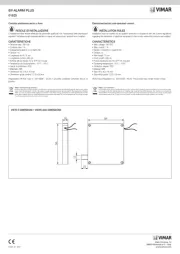
2 Juli 2025

2 April 2025

2 April 2025
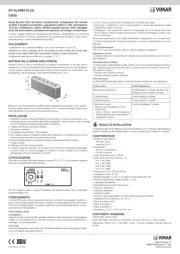
2 April 2025

2 April 2025

2 April 2025
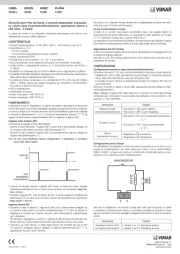
1 April 2025

1 December 2024

1 December 2024
Handleiding Alarmsysteem
- Monacor
- Elro
- Renkforce
- Optex
- Dahua Technology
- Godrej
- Kidde
- Denver
- Konyks
- Nedis
- Greisinger
- Swann
- Gripo
- RCF
- Kemo
Nieuwste handleidingen voor Alarmsysteem
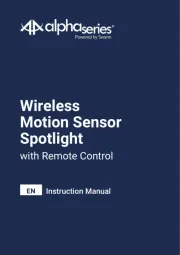
14 Augustus 2025
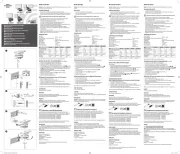
5 Augustus 2025
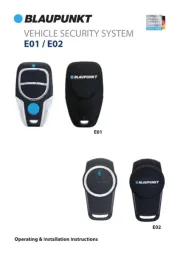
5 Augustus 2025

29 Juli 2025

20 Juli 2025
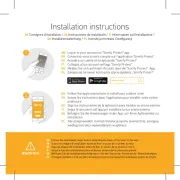
14 Juli 2025

14 Juli 2025

14 Juli 2025
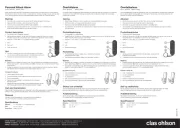
14 Juli 2025

14 Juli 2025